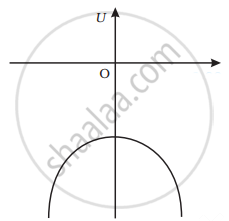Advertisements
Advertisements
Question
Two charges – q each are separated by distance 2d. A third charge + q is kept at mid point O. Find potential energy of + q as a function of small distance x from O due to – q charges. Sketch P.E. v/s x and convince yourself that the charge at O is in an unstable equilibrium.
Solution

U = `1/(4piε_0) {(-q^2)/((d - x)) + (-q^2)/((d - x))}`
U = `(-q^2)/(4piε_0) (2d)/((d^2 - x^2))`
`(dU)/(dx) = (-q^2 . 2d)/(4piε_0) . (2x)/((d^2 - x^2)^2`
U0 = `(2q^2)/(4piε_0d) (dU)/(dx)` = 0 at x = 0
x = 0 is an equilibrium point.
`(d^2U)/(dx^2) = ((-2dq^2)/(4piε_0)) [2/((d^2 - x^2)^2) - (8x^2)/((d^2 - x^2)^3)]`
= `((-2dq^2)/(4piε_0)) 1/((d^2 - x^2)^3) [2(d^2 - x^2)^2 - 8x^2]`
At x = 0
`(d^2U)/(dx^2) = ((-2dq^2)/(4piε_0)) (1/d^6) (2d^2)`, which is < 0.
Hence, unstable equilibrium.
APPEARS IN
RELATED QUESTIONS
Explain briefly the process of charging a parallel plate capacitor when it is connected across a d.c. battery
In a parallel plate capacitor with air between the plates, each plate has an area of 6 × 10−3 m2 and the distance between the plates is 3 mm. Calculate the capacitance of the capacitor. If this capacitor is connected to a 100 V supply, what is the charge on each plate of the capacitor?
The plates of a parallel plate capacitor have an area of 90 cm2 each and are separated by 2.5 mm. The capacitor is charged by connecting it to a 400 V supply.
(a) How much electrostatic energy is stored by the capacitor?
(b) View this energy as stored in the electrostatic field between the plates, and obtain the energy per unit volume u. Hence arrive at a relation between u and the magnitude of electric field E between the plates.
In a parallel plate capacitor with air between the plates, each plate has an area of 6 × 10−3m2 and the separation between the plates is 3 mm.
- Calculate the capacitance of the capacitor.
- If this capacitor is connected to 100 V supply, what would be the charge on each plate?
- How would charge on the plates be affected, if a 3 mm thick mica sheet of k = 6 is inserted between the plates while the voltage supply remains connected?
A parallel-plate capacitor is charged to a potential difference V by a dc source. The capacitor is then disconnected from the source. If the distance between the plates is doubled, state with reason how the following change:
(i) electric field between the plates
(ii) capacitance, and
(iii) energy stored in the capacitor
A parallel-plate capacitor with plate area 20 cm2 and plate separation 1.0 mm is connected to a battery. The resistance of the circuit is 10 kΩ. Find the time constant of the circuit.
A parallel-plate capacitor is filled with a dielectric material of resistivity ρ and dielectric constant K. The capacitor is charged and disconnected from the charging source. The capacitor is slowly discharged through the dielectric. Show that the time constant of the discharge is independent of all geometrical parameters like the plate area or separation between the plates. Find this time constant.
A parallel plate air condenser has a capacity of 20µF. What will be a new capacity if:
1) the distance between the two plates is doubled?
2) a marble slab of dielectric constant 8 is introduced between the two plates?
Answer the following question.
Describe briefly the process of transferring the charge between the two plates of a parallel plate capacitor when connected to a battery. Derive an expression for the energy stored in a capacitor.
A parallel plate capacitor filled with a medium of dielectric constant 10, is connected across a battery and is charged. The dielectric slab is replaced by another slab of dielectric constant 15. Then the energy of capacitor will ______.
